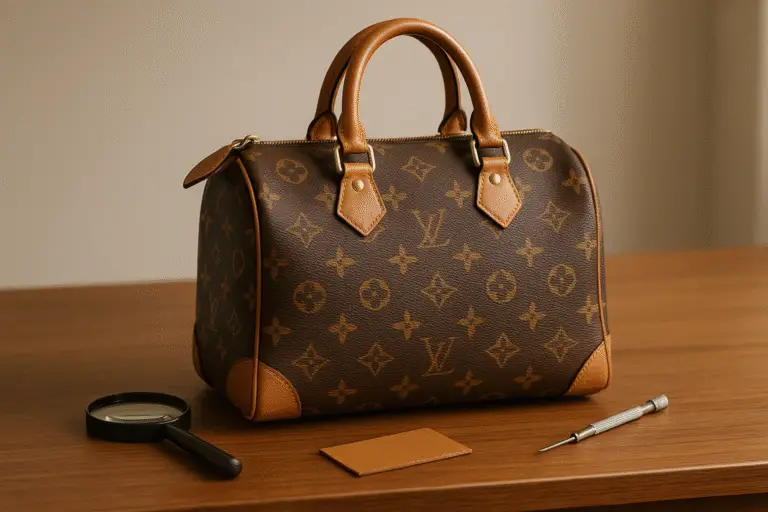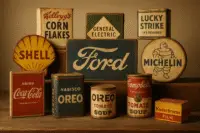Vintage designer handbags are highly sought after, but counterfeits are everywhere. To ensure you’re not getting scammed, here’s what to check:
- Materials: High-end leather, precise stitching, and durable hardware that ages gracefully.
- Brand-Specific Details: Each brand has unique markers:
- Chanel: Look for engraved locks, weighty hardware, and serial numbers.
- Louis Vuitton: Check monogram alignment, date codes, and natural leather aging.
- Gucci: Verify serial numbers, consistent stitching, and aligned patterns.
- Serial Numbers and Tags: Ensure they’re clean, evenly spaced, and match the production period.
- Professional Services and Tools: Use experts or digital tools for tough cases.
Combining these steps with expert help, if needed, can protect your investment and ensure you’re buying a genuine piece.
Real vs. Fake! Shopping Vintage Gucci, Chanel, Tory Burch Handbags – Thrift with Me Dr. Lori
Brand-Specific Verification Markers
Luxury brands often include distinct details that make it easier to identify authentic pieces and weed out counterfeits. These details showcase the brand’s craftsmanship and serve as a helpful starting point for authenticating vintage designer handbags. They work hand-in-hand with broader checks on materials and construction, which we’ll cover in later sections.
Chanel: Key Verification Features
When examining a Chanel handbag, pay attention to these details:
- Authenticity documents: High-quality print and precise details are a must.
- Locks: Test the lock to ensure it operates smoothly and features engraved logos that are consistent and clear.
- Hardware: Genuine Chanel hardware should have a uniform finish and feel weighty, reflecting the brand’s quality.
Louis Vuitton: Spotting Real Pieces
For Louis Vuitton handbags, focus on these indicators:
- Monogram alignment: Patterns should align perfectly, especially on seams and pockets.
- Date code: Look for a date code on a leather tag, formatted according to Louis Vuitton’s standards.
- Leather aging: Authentic pieces often show natural aging with a subtle patina over time.
- Zippers and fittings: These should operate smoothly and have a consistent, polished finish.
Gucci: Signs of Real Handbags
To verify a Gucci handbag, check the following:
- Serial number: Look for a stamped or embossed serial number on the leather patch. The logo embossing should be crisp and evenly spaced.
- Metal hardware: All hardware should match in color and finish.
- Fabric or canvas patterns: Patterns should be aligned and consistent throughout.
- Stitching: Examine the stitching for straight, even seams that reflect high-quality craftsmanship.
These brand-specific markers are a great starting point for authenticating vintage designer handbags. By focusing on these details, you can build a solid foundation for identifying genuine pieces.
Checking Materials and Construction
Stitching Quality
The stitching on a vintage bag can tell you a lot about its authenticity and craftsmanship. High-quality, genuine vintage bags are known for their precise, consistent stitching – a hallmark of expert workmanship. Pay attention to how the stitching looks: it should be tight, even, and clean. Loose threads or any visible flaws in the stitching are red flags. Uneven seams can signal poor quality or potential problems with the bag’s condition. If you notice repairs, check whether they match the original stitching pattern – mismatched repairs may suggest significant wear or lower quality. Additionally, ensure the stitching around the logo is perfectly aligned with the logo’s placement and font.
Reading Serial Numbers and Tags
Serial numbers and tags are crucial tools for verifying the authenticity of vintage designer handbags. These unique identifiers, specific to each brand, provide an additional layer of confidence – if you know where to find them and how to interpret them. Every luxury brand has its own system for numbering and tagging, making it essential to familiarize yourself with the nuances of each.
The placement of these identifiers can vary not only between brands but also across different bag styles. For example, Louis Vuitton typically uses date codes stamped onto leather tabs or fabric linings. In contrast, Gucci often includes a serial number tag, sometimes paired with an authenticity card.
Cross-Checking Serial Numbers
Once you’ve located the serial number or date code, the next step is to cross-reference it with official brand resources. This helps confirm the bag’s production period and style. However, keep in mind that counterfeiters often replicate authentic codes, so it’s important to examine the details carefully.
Pay close attention to the format and placement of the serial number. Genuine designer bags feature numbers that are stamped, printed, or embossed with precision. Look for clean, evenly spaced impressions – blurred or irregular markings can be a sign of a fake.
Additionally, inspect the physical characteristics of the tag or area where the serial number appears. Authentic tags use specific materials, fonts, and even adhesives that are challenging to duplicate. Subtle differences, such as text size, background color, or the quality of the embossing, can provide valuable clues about the bag’s authenticity.
Brand-Specific Serial Formats
Each brand has its own approach to serial numbering, and these systems often evolve over time. Understanding these changes is key to accurate authentication. For instance:
- Chanel: Serial number formats vary depending on the production period, with older models using one style and newer ones adopting another.
- Louis Vuitton: Date codes have transitioned from numeric-only systems to formats combining letters and numbers, which indicate specific production details.
- Gucci: Serial numbering practices have also changed over the years, with many authentic bags including an authenticity card that matches the serial number.
Recognizing these evolving formats is crucial. If a bag’s serial number doesn’t align with what you’d expect for its production period, it could be a warning sign of a counterfeit. By understanding these systems, you strengthen your ability to authenticate a bag and prepare yourself for leveraging expert services or digital tools in the next steps.
Using Expert Services and Digital Tools
When your own skills in authentication hit a wall, turning to professional services or digital tools can offer the expertise needed to verify vintage designer handbags. These methods go beyond individual knowledge and bring advanced techniques into the mix, as explored in the sections below.
Professional Verification Services
Professional authentication services rely on certified experts who specialize in examining luxury handbags. These professionals analyze details like the grain of the leather, the precision of the stitching, and the subtle characteristics of hardware to confirm authenticity. They also have access to extensive libraries of genuine examples, allowing them to identify even the smallest shifts in manufacturing techniques or detect evolving counterfeiting tactics.
Digital Verification Tools
While experts provide a wealth of historical knowledge, digital tools bring speed and precision to the table. These tools use high-resolution imaging to analyze microscopic details, such as the texture of the leather, the angles of the stitching, and the engravings on hardware. By comparing these details against secure databases of authenticated items, digital systems can verify an item’s legitimacy with impressive accuracy. Some platforms even generate unique digital fingerprints for each item, offering a lasting record of authenticity.
Mobile apps and online platforms make the process even more accessible, allowing users to upload photos for quick evaluations. However, while these tools are convenient and maintain permanent records, they are most effective when paired with expert reviews. This is especially true for rare vintage items, where digital databases may lack sufficient references.
Comparing Verification Methods
Choosing the right authentication method depends on the handbag’s value, your budget, and how much risk you’re willing to take. Here’s a breakdown of the main options, considering factors like cost, accuracy, and ease of use:
- Self-inspection: While it can help spot glaring red flags, this approach often misses more sophisticated counterfeits. It’s a low-cost option but comes with higher risks.
- Expert verification: Perfect for high-value handbags, this method offers detailed evaluations by professionals. It’s more expensive but provides peace of mind for valuable purchases.
- Digital tools: These offer fast results and are convenient, but they might miss subtle historical or design details that require a trained eye.
For the best results, combining these methods can strike a balance between affordability and accuracy, ensuring you’re making an informed decision.
Conclusion: Key Points for Verifying Vintage Designer Handbags
Verifying vintage designer handbags requires a meticulous approach, focusing on materials, stitching, and brand-specific details. As discussed earlier, a systematic authentication process – using multiple methods – can help ensure the piece is genuine.
Counterfeiters may mimic obvious features like logos or general shapes, but they often fail to replicate finer details. Pay close attention to stitching consistency, the quality of hardware, and the texture of materials. For instance, Chanel handbags made before 2008 feature 24k gold-plated hardware, and Louis Vuitton bags are known for their precise monogram alignment and branded zippers.
It’s also worth noting the value these items can retain. Chanel Classic Flap bags, for example, hold 80–90% of their original retail value. Proper authentication not only protects against counterfeits but also safeguards your financial investment.
Each brand has its own unique markers that serve as reliable indicators of authenticity. Chanel relies on serial number formats, Louis Vuitton uses date codes and monogram precision, and Gucci ensures accurate placement of its iconic GG logo. These markers often evolve over time, making it crucial to stay informed about the specific details for the era of the bag you’re evaluating.
When in doubt, seek assistance from expert authentication services or use digital verification tools. This is especially important for high-value or rare items that may have historical significance. Combining professional insights with your own careful inspection provides an added layer of security.
No single detail can confirm authenticity on its own. The best approach is to combine thorough research, hands-on examination, and professional verification when necessary. If something feels off – whether it’s the price or the details – it’s better to walk away than risk ending up with a counterfeit.
FAQs
What are the most common mistakes people make when authenticating vintage designer handbags themselves?
When it comes to authenticating vintage designer handbags, one of the most frequent missteps is putting too much emphasis on surface details like logos or serial numbers. While these are important, they don’t tell the whole story. True authenticity lies in the finer details – things like stitching, the quality of materials, and the precise placement of logos. These elements should be evaluated together to get a clearer picture.
Another mistake people often make is placing blind trust in sellers without doing proper research. Checking a seller’s credibility and understanding their return policies are crucial steps. On top of that, relying on outdated or untrustworthy authentication methods can easily lead to errors in judgment. To steer clear of these issues, it’s important to take a well-rounded approach. And if you’re ever unsure, turning to professional authentication services or reliable resources can make all the difference.
How can I find out when a vintage designer handbag was made using its serial number or date code?
To figure out when a vintage designer handbag was made, start by locating its serial number or date code, typically found inside the bag. These codes are a key clue to uncovering manufacturing details.
Take Chanel, for instance. Their date codes, introduced in the mid-1980s, can pinpoint the production year of a bag. Louis Vuitton, on the other hand, uses date codes that include details like the country of production and the specific week or month and year. For example, a code like SD1132 means the bag was made in France during the 13th week of 2012. Brands like Dior and Celine also have their own unique systems for marking production dates.
For the most accurate results, compare these codes to brand-specific authentication guides or seek help from professional authentication services. This process not only confirms the bag’s production period but also ensures its authenticity, giving you peace of mind about your vintage treasure.×
What are the benefits of using digital tools versus expert services to authenticate vintage designer handbags?
Digital tools have made authenticating vintage designer handbags faster, easier, and more affordable. They let you verify items remotely, often providing results almost instantly. Plus, you can use them repeatedly for different pieces, making them perfect for quick checks or initial evaluations.
On the other hand, expert services bring a level of precision and depth that digital tools might not match, especially when dealing with high-value or complex items. With their hands-on inspections and specialized expertise, experts can catch subtle details that might slip past a digital scan.
For the best results, consider using both approaches. Start with digital tools for a quick overview, and if needed, follow up with an expert for a more comprehensive evaluation.



